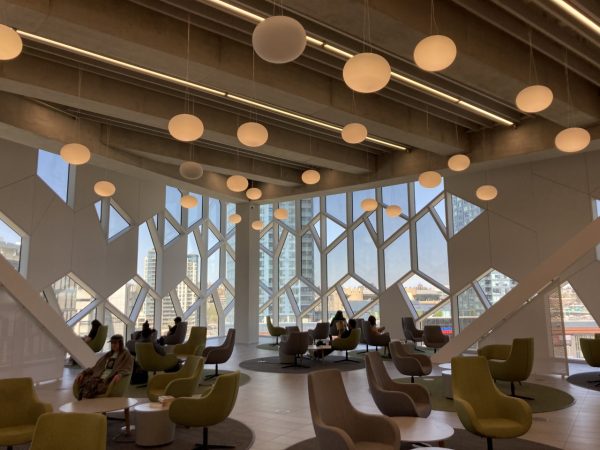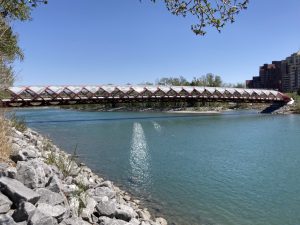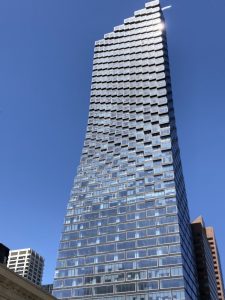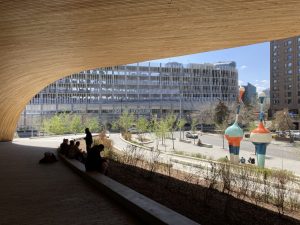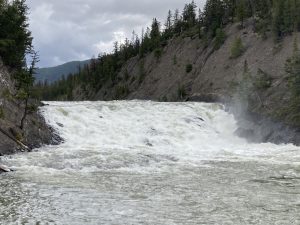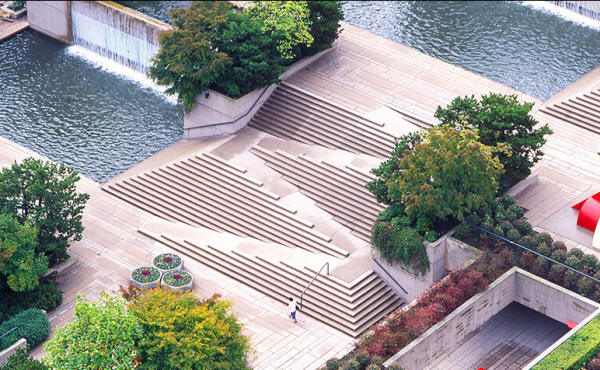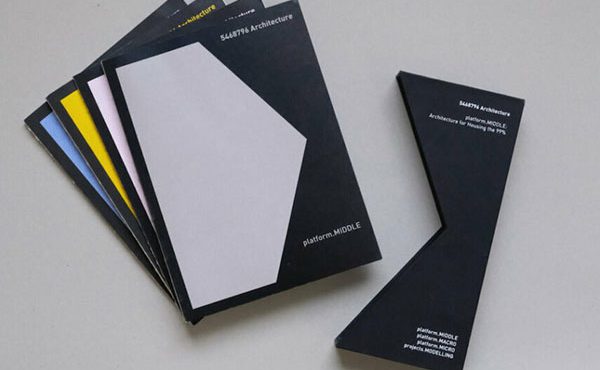
This past month in Calgary, the Royal Architectural Institute of Canada held its first in-person conference since 2019, showcasing the recent opening of several new buildings in and around the downtown core. The City has become a recent hotbed of architectural activity, starting in 2012 with Santiago Calatrava’s Peace Bridge, and leading up to Norman Foster’s Bow Tower, along with a recent Canadian Architect article by Trevor Boddy, who in reviewing Bjarke Ingels Group’s new Telus Sky tower, noted the city is having a bit of an architectural renaissance, with the addition of two new important civic buildings—the library and concert hall—just recently opening on the east side of the Central Business District.
Having grown up in Calgary in the 80’s, I can remember when the Calgary Tower was the tallest building on the skyline, when the then newly opened Saddledome was the only building of note east of City Hall. The buzz in the City ahead of the 1986 Winter Games was similar to that which I experienced in Vancouver ahead of 2010, but still back then in Calgary the large architectural monuments were few and far between. Today’s Calgary skyline is in marked contrast, presently being built out at a staggering rate, with the Bow by Norman Foster now sharing Centre Street with BIG’s Sky Tower in the city’s core at 7th Avenue. The two towers seem to be performing a frozen dance, spatially separated as per zoning but calling to each other across the transit corridor.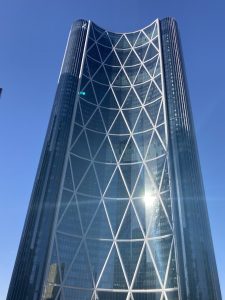 It is a new look for Calgary, especially along the Bow River which has been totally transformed, made necessary by the devastating flooding 10 years ago, and of which Calatrava’s Peace Bridge forms an exclamation point along this new river promenade. Stretching between 8th Street and St. Patrick’s Island, separated pedestrian and cycling paths were filled with people on the sunny Friday afternoon I was there. However, getting to Stephen Avenue Mall from the riverfront is still not a smooth pedestrian experience: the Plus 15 experience Calgary is famous for in the winter but does not translate so well in the summer. Traversing the 4-5 blocks to get to 8th Avenue on the west side of the CBD while not unpleasant as a pedestrian still could use much improvement.
It is a new look for Calgary, especially along the Bow River which has been totally transformed, made necessary by the devastating flooding 10 years ago, and of which Calatrava’s Peace Bridge forms an exclamation point along this new river promenade. Stretching between 8th Street and St. Patrick’s Island, separated pedestrian and cycling paths were filled with people on the sunny Friday afternoon I was there. However, getting to Stephen Avenue Mall from the riverfront is still not a smooth pedestrian experience: the Plus 15 experience Calgary is famous for in the winter but does not translate so well in the summer. Traversing the 4-5 blocks to get to 8th Avenue on the west side of the CBD while not unpleasant as a pedestrian still could use much improvement.
With 8th Avenue downtown known locally as Stephen Avenue Mall, many of the City’s early banks and other notable buildings remain located here, mostly due to the Bankers Hall incorporating many of them into their building design in 1989s. Of all these building the most notable remains the Hudson’s Bay, built in 1913 and added to in 1929 at which time its distinctive arched colonnade was added along Stephen Avenue Mall. But it is a collection of new buildings at the east end of the Mall around City Hall that have recently turned some heads. The first – Studio Bell – opened to critical acclaim in 2016, which as Canada’s new National Music Centre is already a new hub for Calgary’s performing arts scene along with being an eye-popping addition to the downtown’s east end.
Following on the heels of the Bell has been the opening of the new main branch of the city library, designed by Snohetta with DIALOG as Architect of Record. This stunning new space includes a vast swoop of wooden soffit at the building entry, framing east or west Calgary depending on your vantage point. Through the doors and into the great atrium, this great space according to the architects has had its geometry derived from the shape of an Egyptian oil lamp, an ancient symbol of wisdom. It is indeed a great contribution to the City’s public realm, a delightful civic space for both locals and visitors alike.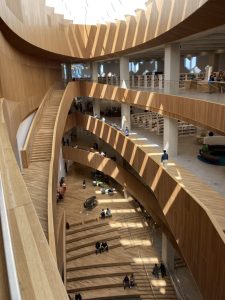
The new library and Bell Centre alone are worth the price of admission for a visit to Calgary, which along with the announcement of a new replacement for the aging Saddledome, will continue to see the City grow skyward. Construction on its C-Train is ongoing, especially as the City continues to expand out from all four of its quadrants. Growing up in NW Calgary, the foothills of the Rockies were always within sight, and development to the west of Calgary is also ongoing, especially in and around Banff. No visit to Calgary is complete without a quick side trip to Canada’s first national park, the township of which grew at a lightning pace following the discovery of its hot springs in the late 1800’s.
And no visit to Banff is complete without a quick stop at the Banff Springs Hotel, with its accompanying Falls at the confluence of the Spray and Bow Rivers. The first hotel was almost built on the wrong spot, as its original announcement by Canadian Pacific Railway in 1888 spurned a local Banff resident to personally write to Van Horne and tell him he knew a better spot. This incited Van Horne to travel out to Banff and day hike to the location with the local resident, discovering the confluence and realizing he would have to redesign the hotel. Further disarray ensued as the local builders had the north arrow upside-down on the drawings once construction was underway, giving the hotel’s kitchen windows the view of the river and the guest rooms the side of the mountain.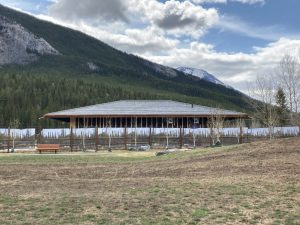
Banff has over the years also been the site of ongoing arts and architectural dialogue, home to the Banff Centre for Arts and Creativity as well as hosting the AAA annual conference every other year at the great hotel. The sleepy little mountain community also caught the attention of Frank Lloyd Wright in the early 1900s, as he designed a park pavilion with one of his apprentices who went on to work at Canada Parks in Ottawa. Unfortunately, the site to the south of the town centre was prone to flooding with the Bow River close by, and every year the building required costly maintenance to keep it habitable. As the story goes, Parks Canada gave instructions to a demolition crew to raze a nearby structure to the Banff pavilion, and when they accidentally started to knock down the pavilion, it is said the orders from Ottawa were to finish the job once and for all.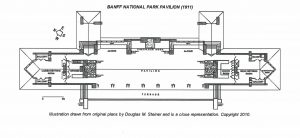
The grounds are still used for recreation, with a well-used skateboard park and baseball diamond on the site where the pavilion once stood. A new community centre facility on the grounds has recently been built by the township, to include change rooms and washrooms, and which was almost completed during a recent visit. Given the history of FLW’s structure on the site, one cannot help but notice the similar roofline of the new structure to the original. The design-build contractors are perhaps paying homage to the great master architect, though with a more modern and utilitarian facility, bereft of the multitude of stained glass doors that graced the original structure, and of which only a few black and white images remain.
The news from Calgary and Banff then would appear to be good, and whether you are an urbanite looking to live in the hustle and bustle at the centre of Cowtown, or you prefer to head to the hills and hike the trails in Kananaskis Country, there is much to see and do along the banks of the Bow and Elbow Rivers.
***
Sean Ruthen is a Metro Vancouver-based architect.

